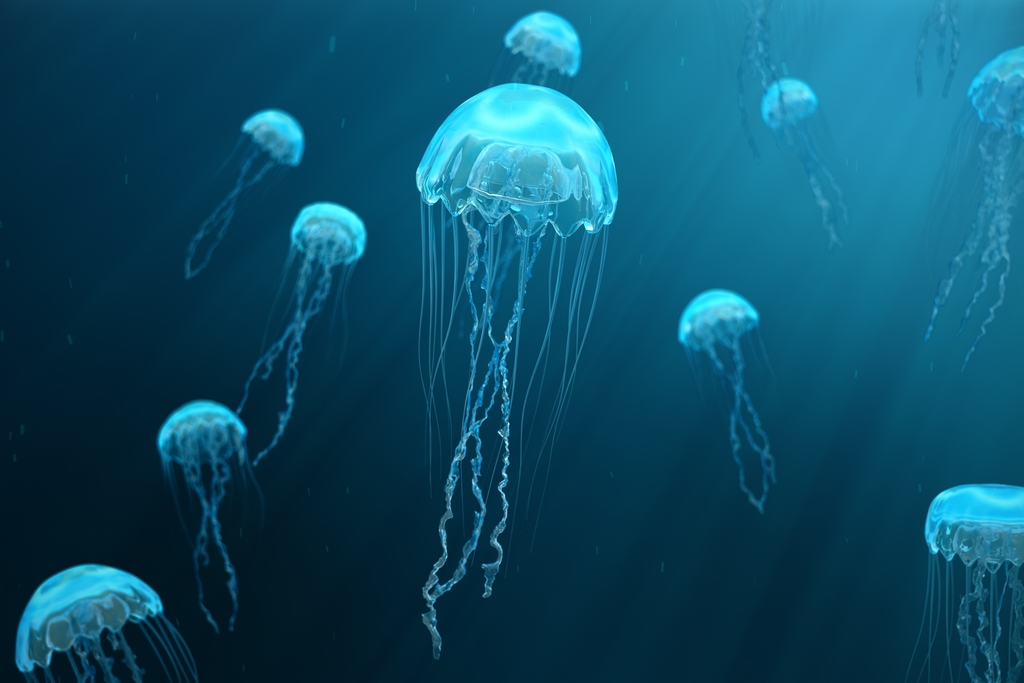In the Company of Jellyfish


Jellyfish are among the oldest and most diverse creatures on earth, and among the most mysterious, occupying a unique niche in the animal kingdom since the dawn of life. Both beautiful and potentially dangerous, science continues to learn evermore fascinating aspects of these translucent denizens of the water.
By Eric Herman
One of my first memories of the ocean was having a jellyfish wash up against my legs while playing in the surf. I had never seen a jellyfish before, had no idea what this thing was that was bobbing next to me. I was terrified.
I grew up frequenting the beaches of Orange Co, CA — places like Corona del Mar, Laguna Beach, Newport Beach and, my teenage stomping ground, Huntington Beach, aka. Surf City. They each had their own character and atmosphere, but one thing they always had in common was the presence of these peculiar floating creatures.
Later in life as I’ve explored ocean environments boating, snorkeling, body surfing, fishing and generally hanging out at the sand’s edge, I’ve been constantly amazed by the variety, beauty and ubiquitous nature of these enigmatic creatures. When I visit aquariums, I’m always most transfixed by the jellyfish displays.
Sometimes they are abundant in a given stretch of ocean, other times very scarce; but, they are almost always there, decorating the waters with an almost ghostly presence. There’s just something about jellyfish that captivate(?) me with each new encounter.
Of course, jellyfish aren’t fish at all, but invertebrates with no brains, heart, blood, scales, fins or gills. Some species do have eyes. Part of the phylum, Cnidaria, they considered a type of plankton. They swim by opening and closing their “bells.” They all have stingers, and I was warned as a kid to never touch them, especially the tentacles. Depending on the species, jellyfish stings can range from mildly painful to almost instantly lethal, and everything between.
Over the years, I’ve compiled a list of jellyfish facts that I’ve always found remarkable.
[] 98% water: By comparison the human body is 60% water. Their elevated water content and lack of pigmentation give them their translucent flesh, which enables them to hide from predators.When jellyfish wash ashore, they don’t last very long as their bodies quickly evaporate, leaving very little behind. Out of water, they literally vanish into thin air.
[] Older than dinosaurs: It’s tough to pin down how far back jellyfish go. They don’t have bones and therefore fossils are relatively rare compared to other species. Those that have been found date back more than 500 million years, three times the age of the oldest dinosaur, making them among the longest living animal species on earth. [] Some are immortal: Strange as it sounds, one species of jellyfish, Turritopsis nutricula, has achieved immorality. It has the amazing ability to undergo a process known as “cellular transdifferation,” a form of physiological regeneration in which it reverts to its pre-sexual, youthful form. Known as the immortal” jellyfish, this amazing creature is being studied with the hope that understanding transdifferation might lead to new types of cancer treatments. [] Diverse and dispersed: There are more than 2,000 species of jellyfish, each with its own unique characteristics and behavior, each with its own crucial role in their ecosystems. They range in size from half an inch to lengths of 120 meters, making them the longest animal in the world. The largest jellyfish by weight, the Nomura’s jellyfish, has a bell over six-feet wide and weighs more than 440 pounds.They live in depths from just a few inches to 700 meters. Jellyfish exist in all oceans and seas. There are a handful of freshwater species that exist in lakes, rivers and reservoirs throughout the world.
[] Floating alone: Jellyfish lead mostly solitary lives and are not typically found in groups unless following a food source or concentrated by way of currents. When they do congregate, a group of jellyfish is known as a bloom, warm, or my favorite, a smack. [] Us and them: Although humans and jellyfish would seem to be about as different as possible, we actually share 60% of our DNA with them. In fact, some scientists believe, based on genetic studies, that comb jellies — one of the oldest known species — may be an early human ancestor, long before life moved to dry land.For the record, I have never been stung by a jellyfish and, for most part, have lost my childhood fear of them. They are an endless source of fascination, especially for those of us who have embraced the joy of their company.










